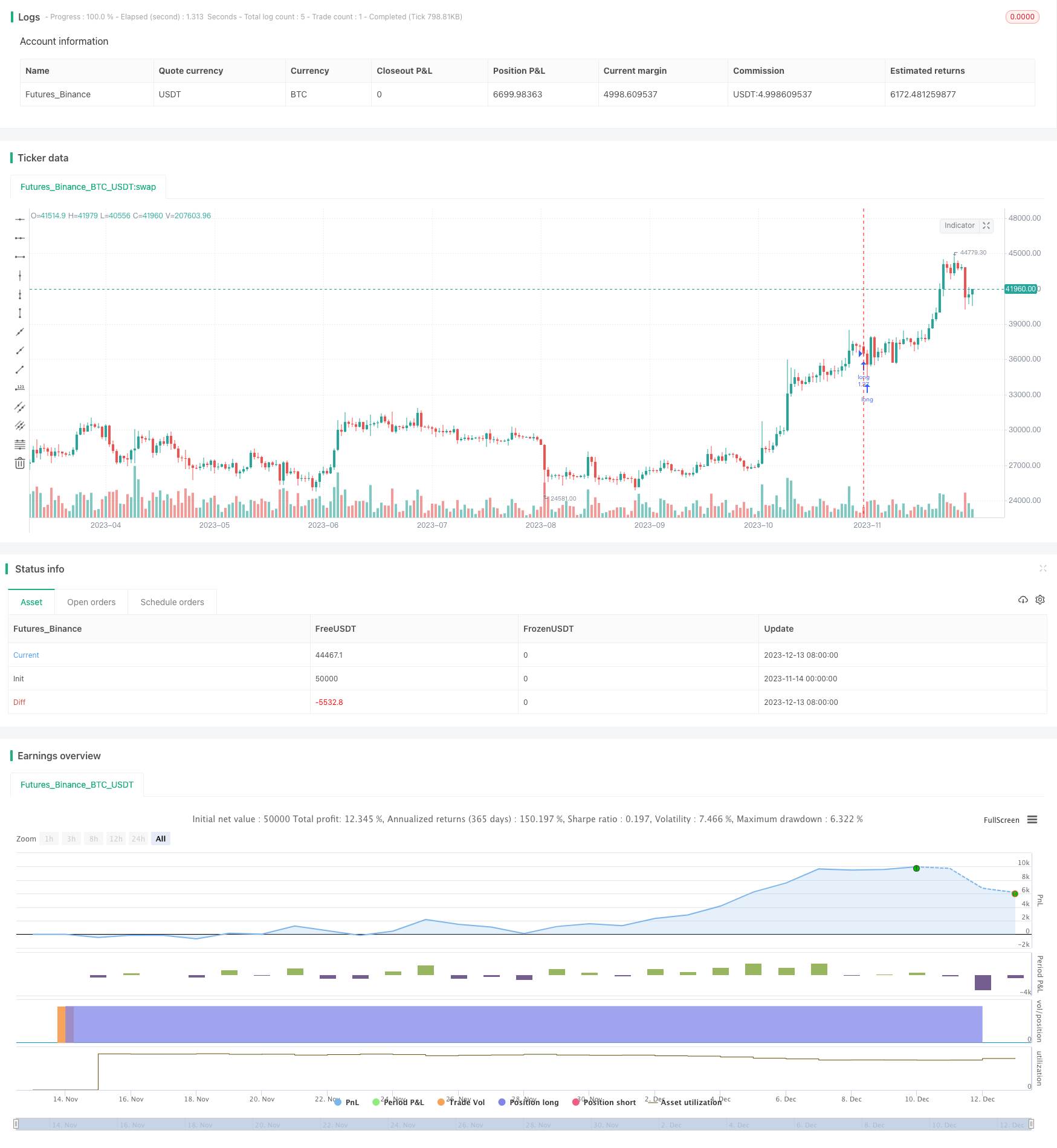
概述
本策略综合运用PSAR指标判断价格趋势、ADX指标判断趋势强弱、RSI指标定位超买超卖区域以及CMF指标判断资金流向,构建出一个跨周期的趋势追踪型量化交易策略。该策略在判断到价格出现盘整突破形成新的趋势方向时快速定位,并在后续趋势中持续跟踪,在保证把握主要趋势收益的同时也设置了过程过滤条件降低持仓风险。
策略原理
本策略主要判断规则如下:
使用PSAR指标判断价格是否处于上升趋势,PSAR下穿价格视为结束上升趋势转为下降;
RSI指标要求高于中线50,以过滤掉超卖区域形成的假突破;
ADX要求高于自身的EMA均线,表示趋势分析结果存在持续信号;
CMF要求大于0,判断为资金流入;
满足以上四个条件时产生买入信号;满足PSAR上穿、RSI低于50、ADX低于自身EMA均线和CMF小于0时产生卖出信号。
该策略综合考量了价格趋势方向、趋势强度、超买超卖状态和资金流向多个维度设置交易规则,在判断产生交易信号时设置了严格的逻辑判断,可有效过滤假突破情况,确保捕捉到高概率可持续的趋势方向。
优势分析
本策略主要具有以下优势:
结合多种指标设置交易规则,可有效防范假突破,确保交易信号质量;
快速定位新生趋势方向并跟踪,可充分把握趋势进程收益;
设置过程跟踪过滤条件,可有效控制风险,确保跟踪效果;
结合趋势强度指标判断,可避免陷入盘整困顿。
风险分析
本策略主要存在以下风险:
单一策略容易堆积风险,需要适当调整仓位控制整体风险;
跟踪过程中需要密切关注过滤条件变化,避免条件取消后产生Loss Cut;
本策略以中长线为主,短期内容易受到波动影响产生止损风险。
对应风险管理措施包括:优化仓位管理规则、设置风险预警线、适当放宽止损线距离等。
优化方向
本策略存在以下优化空间:
优化参数设置,目前参数设置较为主观,可以引入机器学习方法自动优化;
增加仓位管理模块,可以根据风险状况动态调整仓位;
增加止损机制优化,如跟踪止损、时间止损、突破止损等。
总结
本策略综合多种指标判断规则,实现了对新生趋势的快速定位和持续跟踪,验证了量化交易结合趋势与资金等多维度分析的效果。该策略可以作为跨周期趋势跟踪的基础策略进行指数化运用,也可在参数及模块优化后构建成稳定的中长线量化策略。
/*backtest
start: 2023-11-14 00:00:00
end: 2023-12-14 00:00:00
period: 1d
basePeriod: 1h
exchanges: [{"eid":"Futures_Binance","currency":"BTC_USDT"}]
*/
//@version=4
strategy("psar+ adx + cmf + rsi Strategy", overlay=true,initial_capital = 1000, default_qty_type=strategy.percent_of_equity, default_qty_value=100, commission_type=strategy.commission.percent , commission_value=0.1 )
start = input(1.02)
increment = input(1.02)
maximum = input(1.2)
var bool uptrend = na
var float EP = na
var float SAR = na
var float AF = start
var float nextBarSAR = na
if bar_index > 0
firstTrendBar = false
SAR := nextBarSAR
if bar_index == 1
float prevSAR = na
float prevEP = na
lowPrev = low[1]
highPrev = high[1]
closeCur = close
closePrev = close[1]
if closeCur > closePrev
uptrend := true
EP := high
prevSAR := lowPrev
prevEP := high
else
uptrend := false
EP := low
prevSAR := highPrev
prevEP := low
firstTrendBar := true
SAR := prevSAR + start * (prevEP - prevSAR)
if uptrend
if SAR > low
firstTrendBar := true
uptrend := false
SAR := max(EP, high)
EP := low
AF := start
else
if SAR < high
firstTrendBar := true
uptrend := true
SAR := min(EP, low)
EP := high
AF := start
if not firstTrendBar
if uptrend
if high > EP
EP := high
AF := min(AF + increment, maximum)
else
if low < EP
EP := low
AF := min(AF + increment, maximum)
if uptrend
SAR := min(SAR, low[1])
if bar_index > 1
SAR := min(SAR, low[2])
else
SAR := max(SAR, high[1])
if bar_index > 1
SAR := max(SAR, high[2])
nextBarSAR := SAR + AF * (EP - SAR)
//rsi strat
length = input( 50 )
middle_RSI=input(49)
price = close
vrsi = rsi(price, length)
//cmf
lengthCMF = input(20, minval=1)
ad = close==high and close==low or high==low ? 0 : ((2*close-low-high)/(high-low))*volume
mf = sum(ad, lengthCMF) / sum(volume, lengthCMF)
//ADX
adxlen = input(14, title="ADX Smoothing")
dilen = input(14, title="DI Length")
dirmov(len) =>
up = change(high)
down = -change(low)
plusDM = na(up) ? na : (up > down and up > 0 ? up : 0)
minusDM = na(down) ? na : (down > up and down > 0 ? down : 0)
truerange = rma(tr, len)
plus = fixnan(100 * rma(plusDM, len) / truerange)
minus = fixnan(100 * rma(minusDM, len) / truerange)
[plus, minus]
adx(dilen, adxlen) =>
[plus, minus] = dirmov(dilen)
sum = plus + minus
adx = 100 * rma(abs(plus - minus) / (sum == 0 ? 1 : sum), adxlen)
sig = adx(dilen, adxlen)
ema_length=input(10)
ema_sig= ema(sig,ema_length)
long = not uptrend and vrsi > middle_RSI and sig > ema_sig and mf>0
short= uptrend and vrsi < middle_RSI and sig<ema_sig and mf<0
strategy.entry("long",1,when=long)
strategy.close('long',when=short)